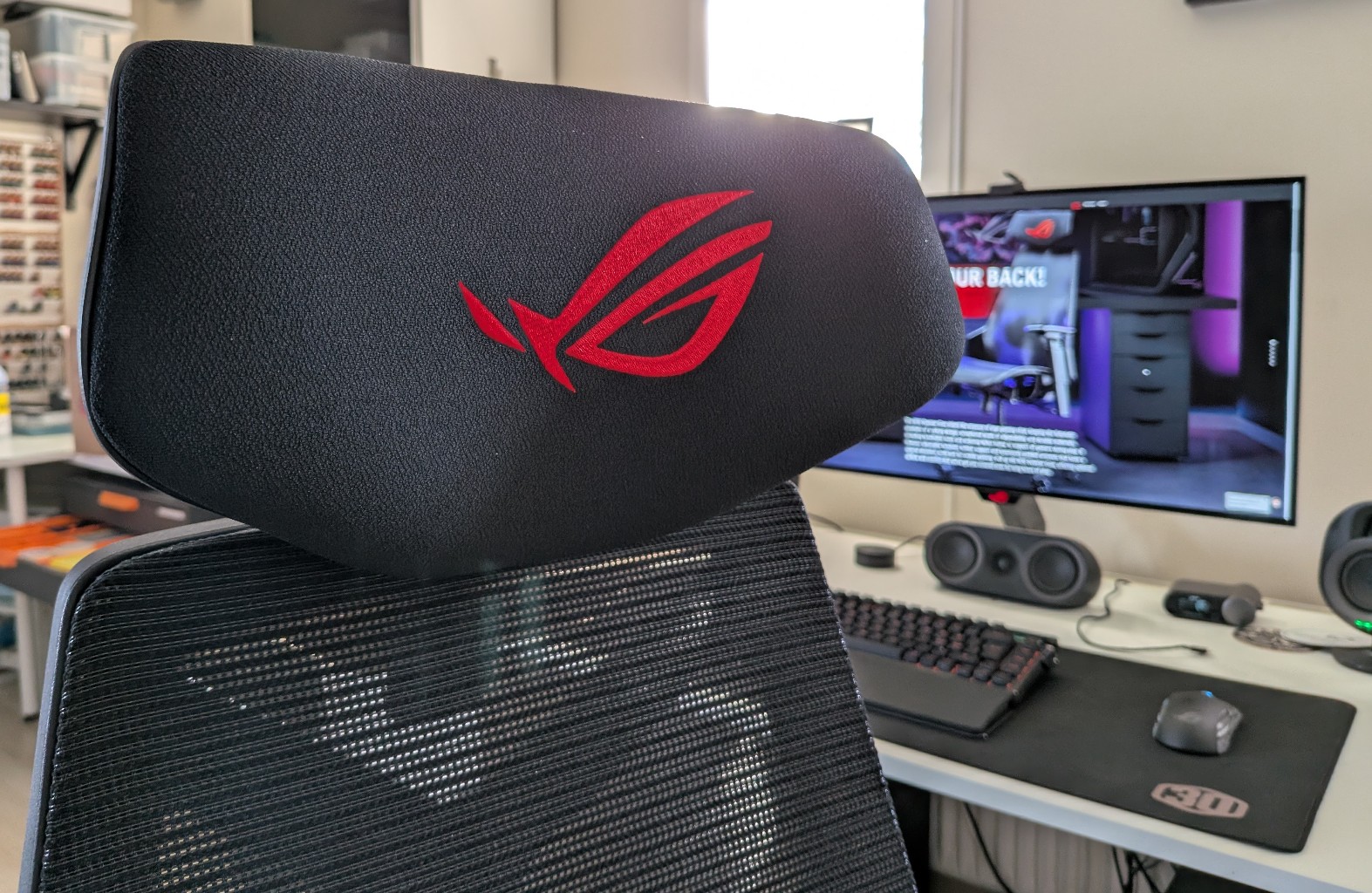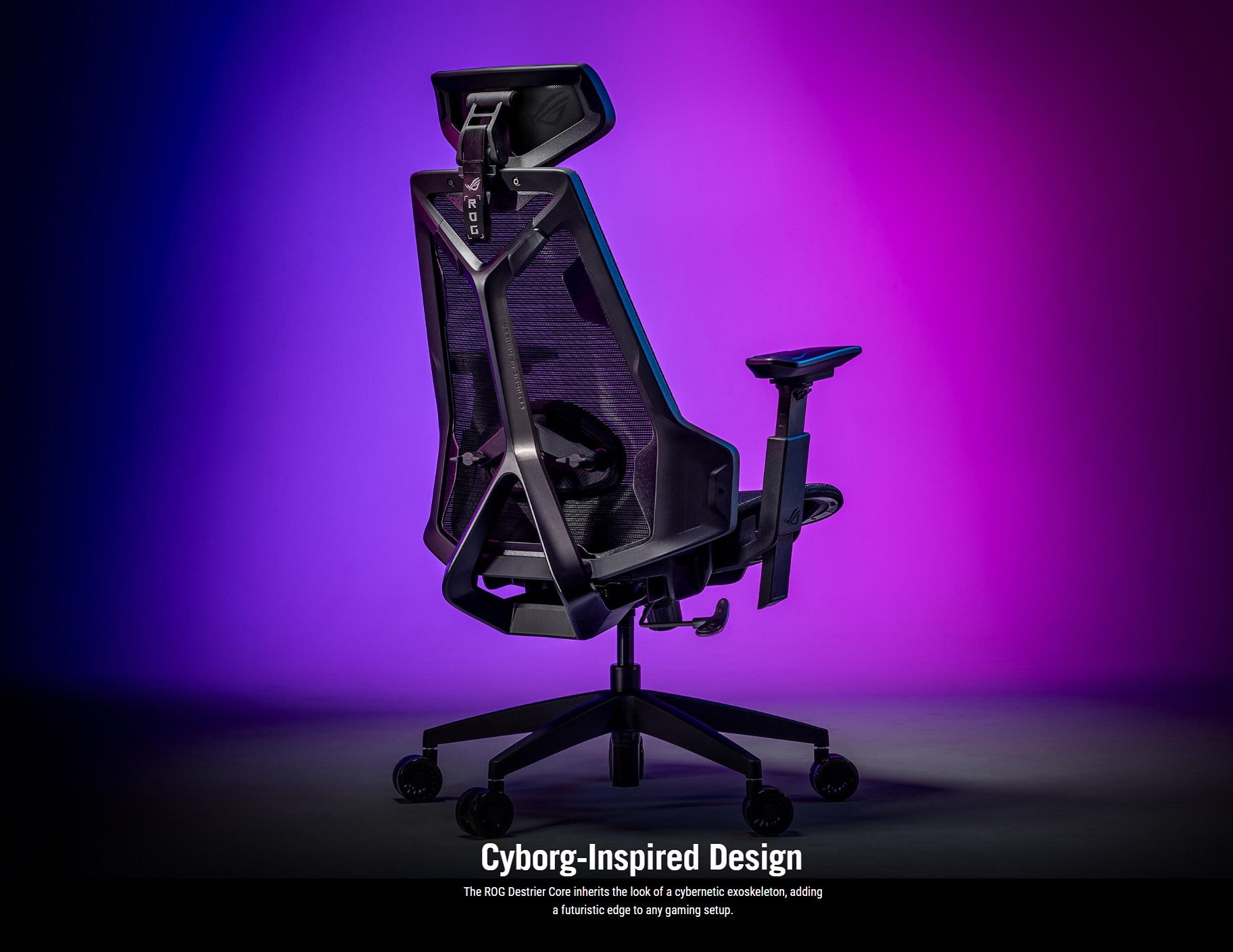ASUS ROG Destrier Core

Key Specifications:
- Style/Type: Ergonomic Gaming Chair
- Recommended Height: 165-185cm
- Recommended Weight: <136kg
- Wheel: 75mm PU Silent Caster
- Tilt Range: 3 angles tilt with tilt lock, 90°/112°/125°
- Dimensions
- Chair: W720mm x D840mm x H1290-1375mm
- Seat: W570mm x D500mm
A tour around the ASUS ROG Destrier Core
Like almost all other gaming chairs on the market, the ROG Destrier Core comes disassembled in a box, and you have to handle the task of assembling the chair yourself. The process is quite straightforward and consists of assembling the frame with wheels and gas cylinder, as well as the chair itself with seat, armrests, and backrest.
All the screws and tools you need are included in the box and ASUS has done a little extra with the tools, which is nice to see.
It took me about 20 minutes to assemble the chair, and the task was pretty straightforward. Screws etc. were clearly marked, so there was no doubt about where each screw should be used.
The end result is a gaming chair that steps away from the now classic racing design that has characterized gaming chairs for a long time. Instead, it's a style that ASUS itself calls the Ergo Gaming Chair.
It's a style that I personally like a lot more, as I'm not particularly fond of the racer design. I don't think it's aesthetically pleasing and I also don't think they're comfortable to wear for long periods of time.
Therefore, I am naturally happy that we are gradually seeing more chairs of this type.
The design of the ROG Destrier follows the slightly futuristic style that we see across ASUS' ROG products very well, and the chair fits in very well with the ROG style. ASUS itself calls it a Cyborg-inspired design.
The materials consist of a combination of metal in the base, while the frame of the chair itself is made of nylon. The seat and backrest are made of a mesh material, which provides a nice degree of breathability, while still being flexible enough to be comfortable.
The frame at the bottom is metal and feels super solid. The Destrier Core comes with 75 mm casters that run smoothly and quietly across the floor.
Instead of a loose neck cushion, as you see on many other chairs, the Destrier Core has a fixed headrest. However, it has a really nice degree of adjustment or can be tilted away completely if you prefer. Here we also find an ASUS ROG logo, so there is no doubt which brand it is.
The two armrests also have a high degree of adjustability. ASUS has made the chair so that it can also be easily used for gaming on mobile devices, such as your smartphone or their own ROG Ally device. This means that the armrests can be raised up to 15 cm, which is significantly more than most other chairs. The result is that you can get a fairly comfortable sitting position if you are gaming on a handheld device.
In addition to the height, the armrest itself can also be adjusted. It can be pushed back and forth and rotated 360 degrees, so you can get the optimal setting.
There are also good options for adjusting your sitting position. There is of course the normal height adjustment, which is adjusted via the gas cylinder in the chair. Here, the Destrier Core is rated for a maximum weight of 136 kilos.
The seat can be pushed back and forth to adjust the seat depth. The backrest can be tilted back freely to 125° and can be locked in three positions of 90°, 112° or 125°.
The final adjustment is the lumbar support, which can be adjusted from the back of the chair. It can be moved up and down to find the position that suits you best. On top of that, it can be adjusted in or out using the two knobs.
Overall, I think the adjustment options on the ASUS ROG Destrier Core are really nice. As you might guess from the name, there is also a regular ROG Destrier (non Core) chair. It has slightly more adjustment options, as well as a minor upgrade in materials and details.
Test
I've had the ROG Destrier Core as my primary office chair for two weeks now, and have been very happy with it.
I have long been tired of the classic racing style gaming chairs, as I have not found the style or seating comfort particularly good. When I switched away from racing style gaming chairs, it was to an IKEA Markus office chair, which has been my primary chair for many years now. The new series of gaming chairs, such as the ASUS ROG Destrier Core, have many similarities with these types of chairs, but both materials and general features have been upgraded.
The Destrier Core has a wealth of adjustment options, meaning that the chair can be adjusted relatively easily and quickly to suit most people. ASUS itself states that the chair is best suited for people with a height between 165 cm and 185 cm and a weight under 135 kg. That's a range that covers a large part of the population, and it also suited me very well.
There are of course the classic settings with height and tilt options. However, Destrier Core also offers good options for adjusting the lumbar support and seat depth. The adjustment of the seat and height is done via the classic tilt mechanisms under the seat. The lumbar support can be pushed up and down, while the adjustment of the depth is done via two screws. All easy and straightforward and I quickly adjusted the chair so that it suited me.
For a very long time, armrests on gaming chairs have been pretty much the same experience, but here too we see some innovation. ASUS has given the Destrier Core the most height adjustment I've seen on any chair. ASUS themselves write that this is to make mobile gaming as comfortable as possible in the chair, which makes good sense. If I put the armrests in the highest setting, it fits with the fact that I get a good sitting position for gaming with a handheld device.
In addition to the height, the armrest can also be pushed back and forth and rotated 360 degrees, which gives a fairly wide range of options. Adjusting the height and rotation requires pressing a button on the armrest, while you can freely slide the armrest back and forth. They are quite tight to move, though, which is an advantage in my book. Other chairs I have tested have been very loose, meaning I can sometimes push them when I get up or sit down in the chair, where I often use the armrests.
Overall, I think the adjustment options on the Destrier Core are some of the best I've seen on a chair of this type. This means that the chair can easily be used in multiple configurations and still provide a comfortable sitting position. These may seem like small things, but overall they give a really good experience with the chair and it means that I've been happy to use it both at the desk in front of the computer and at the hobby table.
Fortunately, the good adjustment options are also followed by good seating comfort. I spend many hours a week in a chair, both in connection with work and hobby geekery, and therefore a good chair is a must if it is to be comfortable for a long time. Here I think that the ASUS ROG Destrier Core has been a pleasant experience.
The materials are comfortable and the chair's design is so open that I don't feel restricted in my sitting position, which can be the case with other chairs where the seat is more like a bowl. I often change my sitting position during the day and sometimes like to have one leg up under me. For that slightly special position, the Destrier Core was completely unrestricted.
Price
I can't currently find the ASUS ROG Destrier Core at any Danish retailers yet. However, ASUS itself has stated a suggested retail price of 650$.
In comparison, the normal Destrier chair currently costs around 900$, so there is a lot to save by choosing the Core variant.
Comparable chairs such as the Fractal Design Refine Mesh can currently be found online for 600$ or a Thunder X3 XTC for around 380$.
Conclusion
The ASUS ROG Destrier Core is a super cool gaming chair that steps away from the racing look. The style is unmistakably “gamer” and fits in nicely with the Republic of Gamers style from ASUS. As my wife put it: “It’s quite masculine, isn’t it?”
Whether you like the style or not is of course a matter of taste, but personally I think it looks very good with a gaming setup, and it's clearly a better style than the racing chairs.
In terms of comfort, I've been super happy with the ROG Destrier chair. The comfortable mesh material is nice to sit on even for long periods of time, and the many adjustment options mean you can have it set up exactly how you want.
Even though temperature is not a problem right now, I also predict that in the summer you will be happy with the extra breathability that you get with a mesh material.
The ASUS ROG Destrier Core is one of the most comfortable gaming chairs I've tested to date. There are good adjustment options and both the build quality and materials feel solid and well put together.

During my test, I did not experience any annoying creaking noises or anything like I did with the Fractal Design Refine chair, for example.
ASUS has trimmed things down compared to their regular Destrier chair and this has resulted in a solid saving. I haven't tested the regular version myself, so I can't say how much of a difference it makes that there has been a bit of savings on materials, for example, but if you look at the specifications alone, there isn't much difference between the two chairs. This is despite the fact that there is a price difference of almost 290$.
The ASUS ROG Destrier Core is still a chair at the expensive end of the market, but if you like the style, I actually think the price is well spent. I spend many hours a week in my chair for both work and pleasure, so it is very important that I sit well.
In this regard, the Destrier Core hits the spot, and even long days in the chair feel comfortable.
We end up with a final score of 9 and a Great Product Award for a gaming chair that stands out. The price is on the high side, but the combination of design, features, materials and comfort makes it, in my book, a chair that is worth the price.
Advantages:
- Good build quality
- Good materials
- Lots of customization
Disadvantages:
- On the expensive side


Latest gaming chair
-
14 Margaming chair
-
10 Jangaming chair
Noblechair DAWN
-
18 Sepgaming chair
Fractal Design Refine
-
26 Auggaming chair
Corsair TC500 Luxe Gaming Chair
-
06 Jungaming chair
Fractal Design ready with "Gaming" chair
-
04 Jungaming chair
ThunderX3 launches new Flex Pro chair
-
05 Febgaming chair
Thunder X3 XTC
-
15 Decgaming chair
ThunderX Core Loft
Most read gaming chair
Latest gaming chair
-
14 Margaming chair
ASUS ROG Destrier Core
-
10 Jangaming chair
Noblechair DAWN
-
18 Sepgaming chair
Fractal Design Refine
-
26 Auggaming chair
Corsair TC500 Luxe Gaming Chair
-
06 Jungaming chair
Fractal Design ready with "Gaming" chair
-
04 Jungaming chair
ThunderX3 launches new Flex Pro chair
-
05 Febgaming chair
Thunder X3 XTC
-
15 Decgaming chair
ThunderX Core Loft






